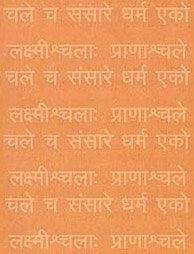Madhyasthya, Mādhyasthya: 12 definitions
Introduction:
Madhyasthya means something in Hinduism, Sanskrit, Jainism, Prakrit, Marathi. If you want to know the exact meaning, history, etymology or English translation of this term then check out the descriptions on this page. Add your comment or reference to a book if you want to contribute to this summary article.
In Hinduism
Samkhya (school of philosophy)
Source: ORA: Amanaska (king of all yogas): (samkhya philosophy)Mādhyasthya (माध्यस्थ्य) refers to “(the state of) neutrality”, according to the Sāṅkhyakārikā.—In Brahmanical literature, udāsīna often means a neutral person, such as in the compound; “friends, neutrals and enemies”. [...] Also, udāsīna has been used in the Sāṅkhyakārikā to qualify the individual soul (puruṣa). After describing the qualities of the Puruṣa as the state of witnessing, isolation, neutrality (mādhyasthya), awareness and non-agency in Kārikā 19, the Sāṅkhyakārikā (20) then qualifies Puruṣa as udāsīna.
Note: Vācaspatimiśra’s commentary on Kārikā 19 equates udāsīna with neutrality (mādhyasthya) and explains the meaning of both in relation to people: “Therefore, because the three Guṇas are absent, neutrality [is mentioned]. A happy person who is satisfied with happiness and a sad person who detests sorrow are not neutral. Thus, one who is neutral is free of [happiness and sorrow] and he is also called udāsīna”.

Samkhya (सांख्य, Sāṃkhya) is a dualistic school of Hindu philosophy (astika) and is closeley related to the Yoga school. Samkhya philosophy accepts three pramanas (‘proofs’) only as valid means of gaining knowledge. Another important concept is their theory of evolution, revolving around prakriti (matter) and purusha (consciousness).
In Jainism
General definition (in Jainism)
Source: archive.org: TrisastisalakapurusacaritraMādhyasthya (माध्यस्थ्य, “indifference”) refers to “indifference to the disrespectful”, according to chapter 1.1 [ādīśvara-caritra] of Hemacandra’s 11th century Triṣaṣṭiśalākāpuruṣacaritra: an ancient Sanskrit epic poem narrating the history and legends of sixty-three illustrious persons in Jainism.—Accordingly:—“[...] after he had thus installed his son in the kingdom, Śatabala himself assumed the sovereignty of tranquillity at the feet of an Ācārya. [... ] With unbroken meditation augmented by the mental attitudes—friendliness, etc. [viz., mādhyasthya], plunged in great joy, he remained always in emancipation, as it were”.
Note: Cf. Tattvārthādhigamasūtra 7.6. Yogaśāstra 4.117.

Jainism is an Indian religion of Dharma whose doctrine revolves around harmlessness (ahimsa) towards every living being. The two major branches (Digambara and Svetambara) of Jainism stimulate self-control (or, shramana, ‘self-reliance’) and spiritual development through a path of peace for the soul to progess to the ultimate goal.
Languages of India and abroad
Marathi-English dictionary
Source: DDSA: The Molesworth Marathi and English Dictionarymādhyasthya (माध्यस्थ्य).—n S pop. mādhyasthī & mādhyasthagirī f Management between parties, mediation.
Marathi is an Indo-European language having over 70 million native speakers people in (predominantly) Maharashtra India. Marathi, like many other Indo-Aryan languages, evolved from early forms of Prakrit, which itself is a subset of Sanskrit, one of the most ancient languages of the world.
Sanskrit dictionary
Source: DDSA: The practical Sanskrit-English dictionaryMādhyasthya (माध्यस्थ्य).—
1) Impartiality; निर्माध्यस्थ्याच्च हर्षाच्च बभाषे दुर्वचं वचः (nirmādhyasthyācca harṣācca babhāṣe durvacaṃ vacaḥ) Rām.2.11.11.
2) Indifference. unconcern; अभ्यर्थनाभङ्गभयेन साधुर्माध्यस्थ्यमिष्टेऽप्यवलम्बतेऽर्थे (abhyarthanābhaṅgabhayena sādhurmādhyasthyamiṣṭe'pyavalambate'rthe) Kumārasambhava 1.52; कैवल्यं माध्यस्थ्यम् (kaivalyaṃ mādhyasthyam) Sāṃkhyakārikā 19.
3) Intercession, mediation.
Derivable forms: mādhyasthyam (माध्यस्थ्यम्).
See also (synonyms): mādhyastha.
Source: Cologne Digital Sanskrit Dictionaries: Shabda-Sagara Sanskrit-English DictionaryMādhyasthya (माध्यस्थ्य).—n.
(-sthyaṃ) Mediation, intercession. E. madhyastha and ṣyañ aff.
Source: Cologne Digital Sanskrit Dictionaries: Benfey Sanskrit-English DictionaryMādhyasthya (माध्यस्थ्य).—i. e. madhyastha + ya, n. 1. Mediation. 2. Office of an arbiter, Lass 92, 4.
Source: Cologne Digital Sanskrit Dictionaries: Cappeller Sanskrit-English DictionaryMādhyasthya (माध्यस्थ्य).—[neuter] indifference, neutrality.
Source: Cologne Digital Sanskrit Dictionaries: Monier-Williams Sanskrit-English Dictionary1) Mādhyasthya (माध्यस्थ्य):—[=mādhya-sthya] [from mādhya] n. ([from] madhya-stha) = [preceding] n., [Dhūrtasamāgama]
2) [v.s. ...] intercession, mediation, [Horace H. Wilson]
Source: Cologne Digital Sanskrit Dictionaries: Yates Sanskrit-English DictionaryMādhyasthya (माध्यस्थ्य):—(sthyaṃ) 1. n. Mediation.
Source: DDSA: Paia-sadda-mahannavo; a comprehensive Prakrit Hindi dictionary (S)Mādhyasthya (माध्यस्थ्य) in the Sanskrit language is related to the Prakrit word: Majjhattha.
[Sanskrit to German]
Sanskrit, also spelled संस्कृतम् (saṃskṛtam), is an ancient language of India commonly seen as the grandmother of the Indo-European language family (even English!). Closely allied with Prakrit and Pali, Sanskrit is more exhaustive in both grammar and terms and has the most extensive collection of literature in the world, greatly surpassing its sister-languages Greek and Latin.
See also (Relevant definitions)
Partial matches: Madhya.
Full-text: Madhyastha, Majjhattha, Neutrality, Madhyamasthya, Kaivalya, Duhkhin, Ubhayarahita, Ubhaya, Duhkha, Traigunya, Tripyat, Ashrita.
Relevant text
Search found 3 books and stories containing Madhyasthya, Mādhyasthya, Madhya-sthya, Mādhya-sthya; (plurals include: Madhyasthyas, Mādhyasthyas, sthyas). You can also click to the full overview containing English textual excerpts. Below are direct links for the most relevant articles:
Tattvartha Sutra (with commentary) (by Vijay K. Jain)
Verse 7.11 - The observances of Benevolence, Joy, Compassion and Tolerance < [Chapter 7 - The Five Vows]
The Tattvasangraha [with commentary] (by Ganganatha Jha)
Verse 1779 < [Chapter 20 - Examination of Syādvāda (doctrine)]
Verse 1777-1778 < [Chapter 20 - Examination of Syādvāda (doctrine)]
Trishashti Shalaka Purusha Caritra (by Helen M. Johnson)
Part 6: Fourth incarnation as Mahābala < [Chapter I]